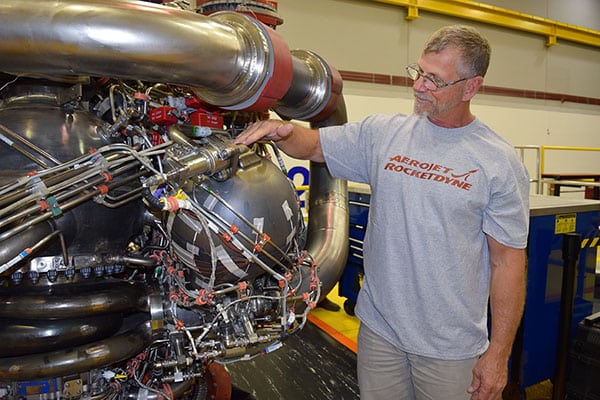Latest News

An Aerojet Rocketdyne technician inspects the 3D-printed pogo accumulator assembly on an RS-25 development engine at the Aerojet Rocketdyne facility located at NASA’s Stennis Space Center. Photo: Aerojet Rocketdyne.
Aerojet Rocketdyne and NASA completed hot-fire testing of an RS-25 rocket engine containing its largest additively manufactured component to date. NASA believes additive manufacturing, commonly known as 3D printing, will help lower the cost of future missions of its Space Launch System (SLS) heavy-lift rocket.
During the 400-second test at NASA’s Stennis Space Center, Aerojet Rocketdyne was able to evaluate the performance of a 3D-printed vibration dampening device, known as a pogo accumulator assembly, which the company manufactured at its facility in Los Angeles, California. The pogo accumulator assembly acts as a shock absorber to dampen oscillations caused by propellants as they flow between the vehicle and the engine. The part is important to ensuring a safe flight by stabilizing these potential oscillations, Aerojet Rocketdyne stated.
The pogo accumulator assembly consists of two components: the pogo accumulator and pogo-z baffle. Both were made using a 3D printing technique called selective laser melting, which uses lasers to fuse metal powder into a pattern by adding layer upon layer of material to produce the part. On the pogo accumulator alone, the new manufacturing technique reduced the number of welds by 78 percent, Aerojet Rocketdyne stated.
The SLS, designed to send astronauts and cargo to explore the moon and other deep-space destinations, will use four Aerojet Rocketdyne-built RS-25 engines.
Aerojet Rocketdyne installed and tested the new 3D-printed components on a development engine that is used to test new technologies that are being incorporated into the RS-25 as part of the SLS program. Earlier this year, the company tested new flight controllers on the same development engine prior to incorporating them into the Exploration Mission 1 flight engines.
“As Aerojet Rocketdyne begins to build new RS-25 engines beyond its current inventory of 16 heritage shuttle engines, future RS-25 engines will feature dozens of additively-manufactured components,” said Dan Adamski, RS-25 program director at Aerojet Rocketdyne. “One of the primary goals of the RS-25 program is to lower the overall cost of the engine while maintaining its reliability and safety margins. Additive manufacturing is essential to achieving that goal.”
Get the latest Via Satellite news!
Subscribe Now